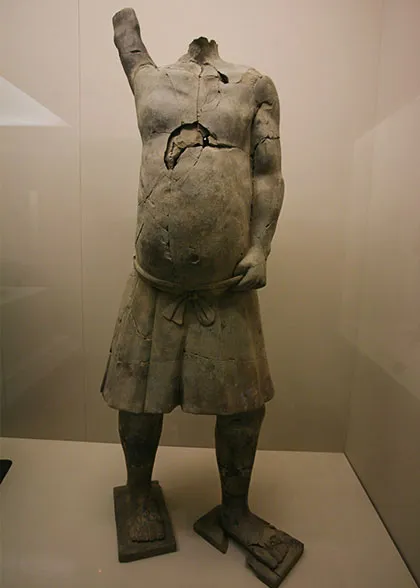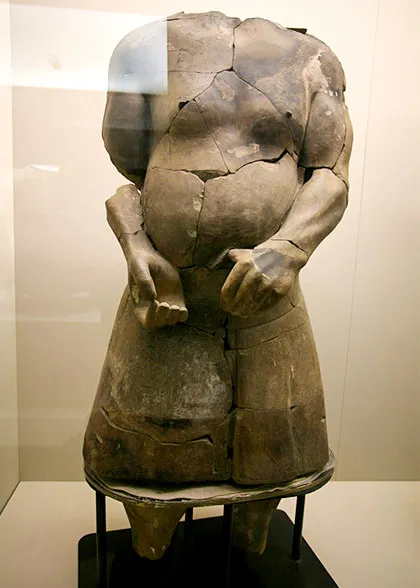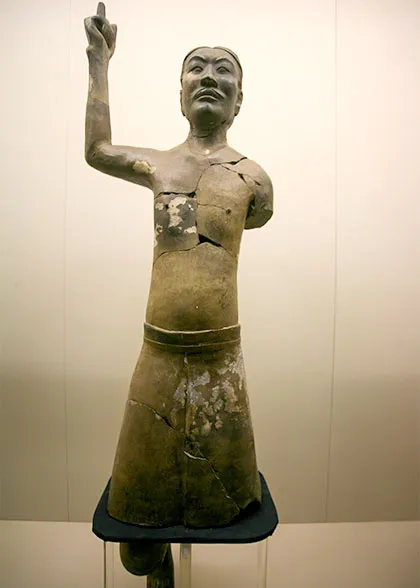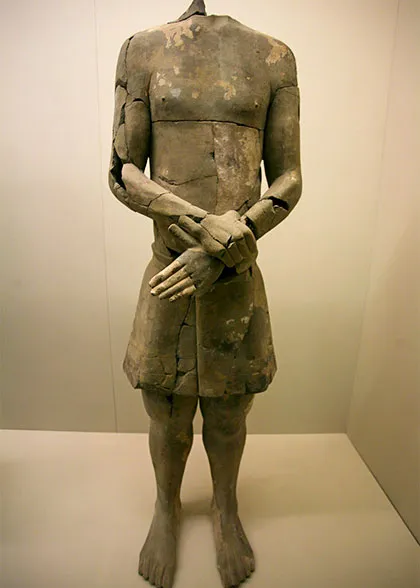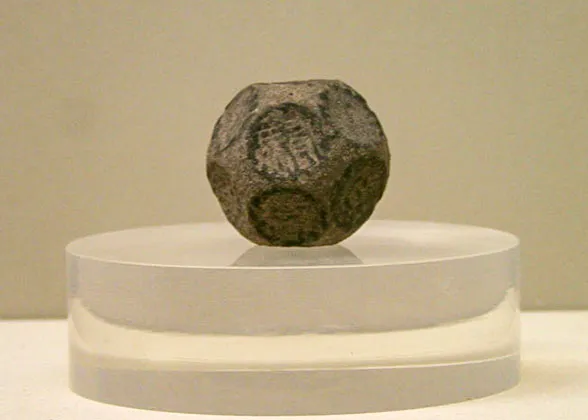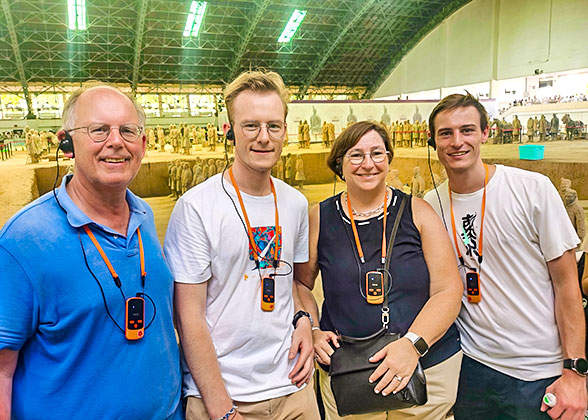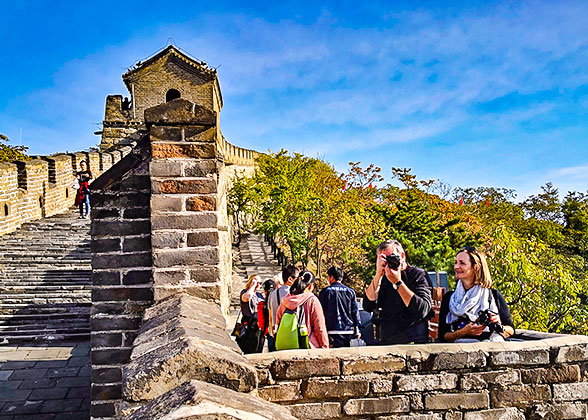Pit K9901 – Acrobatics Figures
In March 1999, Pit K9901, also known as "Acrobatics Figures Pit", was discovered in the southeast area of the Qin Shi Huang Mausoleum, between the inner and outer walls. Acrobatics is the general name for ancient acrobatic and musical performances. Measuring 40 meters (130 feet) long from east to west and spanning approximately 700 square meters (840 square yards), the pit has been excavated to reveal two bronze tripods, over 30 terracotta figures, and other relics, including pottery basins and bronze hemispherical vessels.
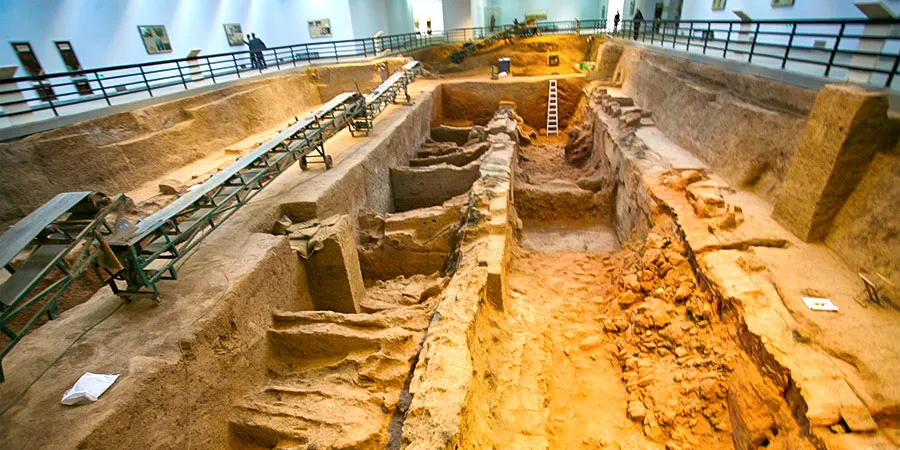 |
| Pit K9901 |
The terracotta figures are life-sized, bare-chested, and wear short skirts, showing a variety of body types from muscular strength-type performers to slender skill-type acrobats. They are depicted in different dynamic poses: some dancing, others lifting tripods or climbing poles, vividly presenting an active court performance. It reveals that as early as the Qin Dynasty (221-207 BC), before 2,000 years ago, watching performances was already one of the royal entertainment activities.
Must-see Cultural Relics in Pit K9901
1. Acrobatics Figure No.3 of 1999 - Tripod-lifting Figure
Unearthed in 1999, this headless figure stands 1.9 meters (6.2 feet) tall. He stands with chest thrust out, belly slightly bulging, right arm raised, and left thumb tucked into his belt. The left leg is bent forward while the right foot firmly steps on the ground. Bare-chested with a short skirt, the powerful figure's raised arm and straining posture suggest he's lifting a heavy tripod, earning him the name "Tripod-lifting Figure."
|
|
2. Acrobatics Figure No.5 of 1999 - Pole-holding Figure
Standing 2 meters (6.6 feet) tall, this is one of the strongest figures in the pit. His upper body is bare, wearing a flared short skirt below. His hands are placed in front of his stomach, gripping his square apron rolled into a semi-cylinder with muscular arms. The broad feet and powerful limbs emphasize his physical strength. The gap of around 10 cm (3.9 in.) between his left arm and body suggests he held a wooden pole, identifying him as a pole-holding performer.
3. Acrobatics Figure No.3 of 2012 - Skill-type Performer
This headless figure stands 1.6 meters (5.2 feet) tall with a distinctive posture. His legs spread apart, hands clasped in front of his stomach. He is unclothed except for a short skirt fastened with a belt. Traces of polychrome paint remain on this figure, primarily white with yellow tones best preserved on his upper body. Based on its pose and appearance, it's speculated that this figure may have represented a dancer or a comedic performer specializing in verbal entertainment.
|
|
4. Acrobatics Figure No.4 of 2012 - The Studded-nail-adorned Figure
This figure retains the best-preserved polychrome paint among all the acrobatics figures discovered, distinguished by its exceptionally unique attire. Unlike the other figures, he wears upper clothing with nine rows of studded-nail decorations, totaling about 120 studded nails, which earned it the name of "Studded-nail-adorned Figure." Additionally, his cuffs are ornamented with several geometric patterns, such as black eight-pointed star motifs. His lower clothing is tubular in shape, wider at the bottom. A patterned belt is mostly concealed by the upper clothing, with only the knot visible at the left abdomen.
5. Acrobatics Figure No.28 of 2012 - The Supine Figure
6. Giant Acrobatics Figure
A giant pottery figure was found in Pit K9901 measuring 2.2 meters (7.2 feet) tall without his head, and even his foot is 0.32 meters (1 foot) long.
|
|
7. Stone Dice - The Original Form of Today's Dice
The stone dice, called Shiboqiong, differ significantly from today's dice. It is an egg-sized black polyhedral stone with visible polishing marks on its surface. What makes it unique are its 14 sides, each carefully carved with either a Chinese character or a number. Archaeologists believe this object was used as an entertainment tool for Emperor Qin Shi Huang. Based on its design and function, experts believe that it could be the original form of today's dice.
8. Bronze Tripod - The First Tripod of Qin Shi Huang's Mausoleum
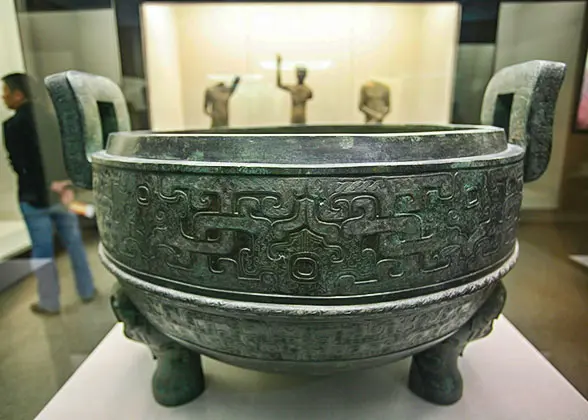 |
| Bronze Tripod |
This bronze tripod is a circular three-legged vessel, standing 61 cm (24 in.) tall with diameters from inner to outer side ranging from 65.5 to 71 cm (25.8 to 28 in.), and a depth of 34 cm (13 in.). Weighing approximately 212 kilograms (467 pounds), it is believed to be the heaviest tripod discovered in the mausoleum. The tripod was found completely intact and its surface is exquisitely carved with intricate animal and cloud patterns. Due to its massive size and exquisite craftsmanship, it was honored as "The First Tripod of Qin Shi Huang's Mausoleum". Experts speculate that it probably served as a performance tool for acrobats who played weightlifting for Emperor Qin Shi Huang.
Travel Information
1. The through ticket of the Terracotta Army has already included the entrance fee of Pit K9901.
2. The free shuttle bus from the Terracotta Army Museum to Qin Shi Huang's Mausoleum Site Park (Lishan Garden) can take you to see this accessory pit.
More Accessory Pits:
![]() Pit K0006 - Civil Official Figures
Pit K0006 - Civil Official Figures![]() Pit K9801 - Stone Armor and Helmets
Pit K9801 - Stone Armor and Helmets![]() Pit K0007 - Bronze Aquatic Birds
Pit K0007 - Bronze Aquatic Birds![]() Further Reading: Why are there partition walls in the pit of Terracotta Army?
Further Reading: Why are there partition walls in the pit of Terracotta Army?
